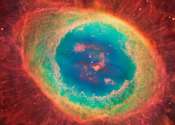The mystery of fullerenes in space explained
A study from the Instituto de Astrofísica de Canarias (IAC) which combines laboratory chemistry with astrophysics, has shown for the first time that grains of dust formed by carbon and hydrogen in a highly disordered state, ...







